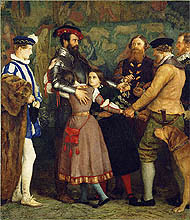• Explain to students that not all narrative art illustrates a well-known story. Sometimes artists
create their own stories or tell stories about people in their lives.
• Tell students that they are going to look at an image that isn't based on any
well-known story.
• Separate students into groups of four.
• Ask one student to be the recorder, and one the reporter. The others in the group will be the detectives.
• Pass out the "What's the Story and How Does it End?" activity sheet, for students to follow and write down their answers.
• Place the image on view.
• Explain that as a group they need to figure out what is going on in this story and make up an ending for it. The detective should come up with a list of five questions he or she would ask the artist to
learn more about the story. The recorder should take notes on the discussion among the group members. The reporter will present the group's findings to the class.
• Give groups enough time to complete this activity.
• Ask reporters to present their findings to the class, including the questions they would ask of the artist and the ending of the story that their group created.
SUGGESTED ACTIVITY
• Ask groups to act out their endings to the story. |
 |
 |
 |
| The Ransom, John Everett Millais, 1860–1862 |
 |
|
 |